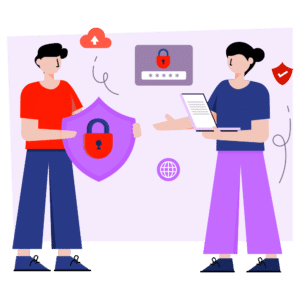In the realm of safeguarding data integrity within Salesforce orgs, the fusion of UX design and cybersecurity emerges as a pivotal strategy. Let’s delve into how UX design serves as a cornerstone in fortifying data security:

User-Centric Security Measures
UX design places users at the forefront, ensuring that security measures are seamlessly integrated into the user experience. By prioritizing intuitive design elements and clear communication, UX designers empower users to engage with Salesforce platforms confidently while adhering to stringent security protocols. This user-centric approach fosters a culture of security awareness and compliance.

Simplified Security Communication
Complex security concepts can be daunting for users, leading to confusion and potential security breaches. UX designers bridge this gap by translating technical jargon into accessible language, ensuring that users understand the importance of security measures and their role in maintaining data integrity. Clear and concise security communication fosters transparency and empowers users to make informed decisions about their digital interactions.

Proactive Vulnerability Mitigation
Collaboration between UX designers and cybersecurity experts enables proactive identification and mitigation of potential vulnerabilities within Salesforce orgs. Through comprehensive audits and rigorous testing, UX designers identify and address security loopholes in user interfaces, minimizing the risk of data breaches and unauthorized access. This proactive approach to vulnerability management enhances the overall security posture of Salesforce platforms.

Transparent Data Handling
Transparency is paramount in building user trust and confidence in data handling practices. UX designers ensure that users are fully informed about the collection, storage, and usage of their personal data within Salesforce orgs. Clear privacy policies, accompanied by user-friendly interfaces, enable users to make informed decisions about data sharing and consent, enhancing transparency and accountability. A case in point is Apple’s privacy labels, which clearly communicate how apps use user data. This transparency fosters trust and encourages users to make informed decisions about their data security.

Data Minimization and Anonymization
UX designers advocate for the principle of data minimization, emphasizing the collection of only essential user data to reduce the risk of data breaches. By minimizing the reliance on cookies and anonymizing personal data where possible, UX design enhances privacy and security without compromising the functionality of your org. This strategic approach to data handling ensures that sensitive information is protected against unauthorized access and misuse.
UX design serves as a linchpin in strengthening data security within Salesforce orgs. Through user-centric design principles, streamlined authentication processes, proactive vulnerability management, and transparent communication, UX designers play a pivotal role in fortifying the integrity of data and safeguarding against evolving cyber threats. By integrating security seamlessly into the user experience, organizations can instill confidence and trust among users while upholding the highest standards of data protection.







